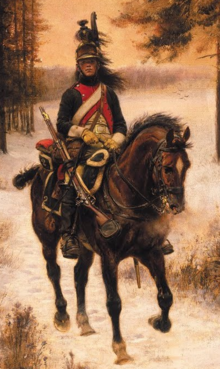2nd Dragoon Regiment (France)
Da materiam splendescam
The 2nd Dragoon Regiment (French: 2e régiment de dragons, 2e RD) is an armoured cavalry unit of the French Army, stationed at Fontevraud-l'Abbaye, by Saumur in Maine-et-Loire. The current regiment is an amalgamation of the old 2nd Dragoon Regiment and the groupe de défense NBC, which took effect in July 2005. It incorporates the capabilities of the previous 2nd Dragoons, which was specialised as a reconnaissance unit, in a new mission as the sole French Army unit dedicated to combatting chemical, biological, radiological, and nuclear (CBRN) weapons.
Despite the recent formation of the regiment in its current configuration, it is the oldest French cavalry regiment, dating back to 1556. The regiment found fame as the personal regiment of Louis, Duke of Enghien and later Prince of Condé, from 1635 to 1686; in honour of the "Grand Condé," it is still called the "Condé-Dragons". The French Revolution gave it the designation of the second regiment of dragoons in the French Army, and with brief interruptions it has served under this name in successive French armies ever since.
The 2nd Dragoons trace their lineage to the formation of a compagnie d'ordonnance by Louis de Bourbon, head of the House of Condé, in 1556. At the time it numbered 50 lances fournies—50 knights, plus about 5 supporting men-at-arms each, for a total of about 300 men. In 1635, this company became the Régiment d'Anguien-Cavalerie, after its proprietor Louis, Duke of Enghien (the future Grand Condé), one of twelve regiments formed by a royal order of 16 May to fight in the war against the Holy Roman Empire. Enghien appointed the Chevalier de Tavannes as the commander (mestre de camp) of the regiment. It immediately was sent to serve in the Italian peninsula, where it probably operated as a collection of independent light cavalry companies. In 1636, it was sent to join the French campaign against Franche-Comté, and it participated in the unsuccessful siege of Dôle that spring. It was reduced to independent companies in July 1636, and restored to a full regiment in January 1638.
...
Wikipedia

